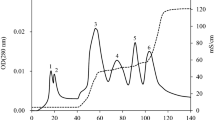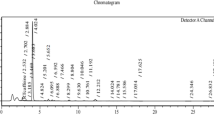Abstract
The culture filtrate of Bacillus subtilis strain C2 showed strong activity against the pathogenic fungus Fusarium solani f. sp. radicicola. A partially purified fraction (PPF) from the extract induced chlamydospore formation in Fusarium. Reverse-phase high performance liquid chromatography yielded 8 different fractions, six of which had chlamydospore-inducing activity. Mass spectrometry and nuclear magnetic resonance analyses identified the main active constituent as C17 fengycin A (FA17), a cyclic lipopeptide. The effect of FA17 on morphology and physiology of two Fusarium species was dependent on the lipopeptide concentration. When challenged with FA17 at concentrations (0.5, 8, 64 μg ml−1) below the minimum inhibitory concentration (MIC) (128 μg ml−1), two species of Fusarium formed chlamydospores from hyphae, germ tubes, or inside the conidia within 2 days. At concentrations close to the MIC, FA17 caused Fusarium to form sparse and swollen hyphae or lysed conidia. The other five fractions were identified as fengycin A homologues. The homologues could also induce chlamydospore-like structures in 17 species of filamentous fungi including some specimens that do not normally produce chlamydospores, according to their taxonomic descriptions. Like other chlamydospores, these structures contained nuclei and lipid bodies as revealed by DAPI and Nile Red staining, and could germinate. This is the first study to demonstrate that under laboratory conditions fengycin, an antifungal lipopeptide produced by B. subtilis, can induce chlamydospore formation in Fusarium and chlamydospore-like structures in many filamentous fungi.




Similar content being viewed by others
References
Altschul, S. F., Madden, T. L., Schaffer, A. A., Zhang, J., Zhang, Z., Miller, W., and Lipman, D. J. 1997. Gapped BLAST and PSI-BLST, a new generation of protein database search programs. Nucl. Acids Res. 25:3389–3402.
Asaka, O. and Shoda, M. 1996. Biocontrol of Rhizoctonia solani damping-off of tomato with Bacillus subtilis RB14. App. Environ. Microbiol. 62:4081–4085.
Bie, X. M., Lu, Z. X., and Lu, F. X. 2009. Identification of fengycin homologues from Bacillus subtilis with ESI-MS/CID. J. Microbiol. Meth. 79:272–278.
de Boer, W., Folman, L. B., Summerbell, R. C., and Boddy, L. 2005. Living in a fungal world: impact of fungi on soil bacterial niche development. FEMS Microbiol. Rev. 29:795–811.
Chan, Y. K., McCormick, W. A., and Seifert, K. A. 2003. Characterization of an antifungal soil bacterium and its antagonistic activities against Fusarium species. Can. J. Microbiol. 49:253–262.
Cobas, C., Cruces, J., and Sardina, F. J. 2000. MestRe-C version 2.3, Universidad de Santiago de Compostela, Spain.
Couteaudier, Y. and Alabouvette, C. 1990. Survival and inoculum potential of conidia and chlamydospores of Fusarium oxysporum f. sp. lini in soil. Can. J. Microbiol. 36:551–556.
Goh, Y. K., Daida, P., and Vujanovic, V. 2009. Effects of abiotic factors and biocontrol agents on chlamydospore formation in Fusarium graminearum and Fusarium sporotrichioides. Biocontrol Sci. Techn. 19:151–167.
Harish, S., Manjula, K., and Podile, A. R. 1998. Fusarium udum is resistant to the mycolytic activity of biocontrol strain of Bacillus Subtilis AF 1. FEMS Microbiol. Ecol. 25:385–390.
Jensen, C. D. E., Percich, J. A., and Graham, P. H. 2002. Integrated management strategies of bean root rot with Bacillus subtilis and Rhizobium in Minnesota. Field Crop Res 74:107–115.
Kinsella, K., Schilthess, C. P., Morris, T. F., and Stuart, J. D. 2009. Rapid quantification of Bacillus subtilis antibiotics in the rhizosphere. Soil Biol. Biochem. 41:374–379.
Kloepper, J. W., Lifshitz, R., and Zablotowicz, M. 1989. Free-living bacterial inocula for enhancing crop productivity. Trends Biotechnol. 7:39–44.
Krieg, N. R. and Holt, J. G. 1984. pp. 1104–1139, Bergey’s manual of systematic bacteriology, Vol. 1. Williams and Wilkins, Baltimore, Md.
Lane, D. J. 1991. 16S/23S rRNA sequencing, pp. 115–175, in E. Stackebrandt and M. Goodfellow (eds.), Nucleic Acid Techniques in Bacterial Systematics. Wiley, New York.
Leslie, J. F. and Summerell, B. A. 2006. The Fusarium Laboratory Mannual. Blackwell Publishing, USA.
Li, L., Qu, Q., Tian, B. Y., and Zhang, K. Q. 2005. Induction of chlamydospores in Trichoderma harzianum and Glioladium roseum by antifungal compounds produced by Bacillus subtilis C2. J. Phytopathol. 153:868–693.
Lin, X. R. and Heitman, J. 2005. Chlamydospore formation during hyphal growth in Cryptococcus neoformans. Eukaryot. Cell 4:1746–1754.
Luo, W. F., Yu, S. F., He, C. F., Li, Z. Y., Wang, C. L., and Cui, X. M. 1997. On the combined infection of root rot pathogens on Panax Notoginseng. Acta Phytopathol. Sinica 27:85–91.
Nash, S. M., Christou, T., and Snyder, W. C. 1961. Existence of Fusarium solani f. phaseoli as chlamydospores in soil. Phytopathology 51:308–312.
Nelson, P. E., Dignani, M. C., and Anaissie, E. J. 1994. Taxonomy, biology, and clinical aspects of Fusarium species. Clin. Microbiol. Rev. 7:479–504.
Nielsen, T. H., Thrane, C., Christophersen, C., Anthoni, U., and Sørensen, J. 2000. Structure, production characteristics and fungal antagonism of tensin—a new antifungal cyclic lipopeptide from Pseudomonas fluorescens strain 96.578. J. App. Microbiol. 89:992–1001.
Ongena, M. and Jacques, P. 2008. Bacillus lipopeptides: versatile weapons for plant disease biocontrol. Trends Microbiol. 16:115–125.
Ongena, M., Jourdan, E., Adam, A., Paquot, M., Brans, A., Joris, B., Arpigny, J. L., and Thonart, P. 2007. Surfactin and fengycin lipopeptides of Bacillus subtilis as elicitors of induced systemic resistance in plants. Environ. Microbiol. 9:1084–1090.
Raaijmakers, J. M., Brujin, I. D., Nybroe, O., and Ongena, M. 2010. Natural functions of lipopeptides from Bacillus and Pseudomonas: more than surfactants and antibiotics. FEMS Microbiol. Rev. 34:1037–1062.
Radford, S. A., Johnson, E. M., and Warnock, D. W. 1997. In vitro studies of activity of voriconazole (UK-109,496), a new triazole antifungal agent, against emerging and less-common mold pathogens. Antimicrob. Agents Chemother. 41:841–843.
Romero, D., de Vicente, A., Rakotoaly, R. H., Dufour, S., Veening, J. W., Arrebola, E., Cazorla, F. M., Kuipers, O. P., Paquot, M., and Pérez-García, A. 2007. The iturin and fengycin families of lipopeptides are key factors in antagonism of Bacillus subtilis toward Podosphaera fusca. Mol. Plant Microbe. 20:430–440.
Stevenson, I. L. and Becker, S. A. W. E. 1972. The fine structure and development of chlamydospores of Fusarium oxysporum. Can. J. Microbiol. 18:997–1002.
Umezawa, H., Aoyagi, T., Nishikiori, T., Okuyama, A., Yamagishi, Y., Hamada, M., and Takeuchi, T. 1986. Plipastatins: New inhibitors of phospholipase A2, produced by Bacillus cereus BMG302-fF67. J. Antibiot. 39:737–744.
Vanittanakom, N. P. and Loeffler, W. 1986. Fengycin – A novel antifungal lipopeptide antibiotic produced by Bacillus subtilis F-29-3. J. Antibiot. 39:888–901.
Volpon, L., Besson, F., and Lancelin, J. M. 2000. NMR structure of antibiosis plipastatins A and B from Bacillus subtilis inhibitors of phospholipase A2. FEBS Lett. 485:76–80.
Wüthrich, K. 1986. NMR of Proteins and Nucleic Acids. Wiley Interscience, New York.
Acknowledgments
This work was performed with financial support from the Natural Science Foundation of China under the Grant no. 21162036, 20762014, 30960007, 50761007, 51161025, the Natural Science Foundation of Yunnan province under the Grant no. 2006E0008Q and Major state Basic Research Development Program (2009CB125905). We are grateful to Dr. J-P Xu (McMaster University, Canada) for his critical reading of this manuscript.
Author information
Authors and Affiliations
Corresponding author
Electronic supplementary material
Below is the link to the electronic supplementary material.
Table S1
1H-NMR resonance assignments of fengycin A in DMSO solution at 295 K (DOC 41 kb)
Rights and permissions
About this article
Cite this article
Li, L., Ma, M., Huang, R. et al. Induction of Chlamydospore Formation in Fusarium by Cyclic Lipopeptide Antibiotics from Bacillus subtilis C2. J Chem Ecol 38, 966–974 (2012). https://doi.org/10.1007/s10886-012-0171-1
Received:
Revised:
Accepted:
Published:
Issue Date:
DOI: https://doi.org/10.1007/s10886-012-0171-1




